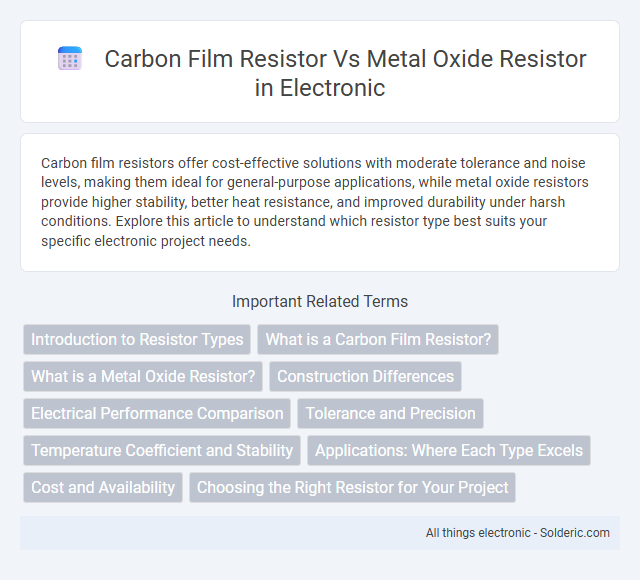Carbon film resistors offer cost-effective solutions with moderate tolerance and noise levels, making them ideal for general-purpose applications, while metal oxide resistors provide higher stability, better heat resistance, and improved durability under harsh conditions. Explore this article to understand which resistor type best suits your specific electronic project needs.
Comparison Table
| Feature | Carbon Film Resistor | Metal Oxide Resistor |
|---|---|---|
| Material | Carbon film | Metal oxide film |
| Temperature Coefficient | Higher (~200 ppm/degC) | Lower (~50-100 ppm/degC) |
| Power Rating | Lower (typically 0.25W to 1W) | Higher (typically 0.5W to 5W) |
| Tolerance | +-5% to +-10% | +-1% to +-5% |
| Noise | Higher noise | Lower noise |
| Stability | Lower long-term stability | Better long-term stability |
| Cost | Lower cost | Higher cost |
| Applications | General purpose, low-cost circuits | High reliability, high power, precision circuits |
Introduction to Resistor Types
Carbon film resistors feature a thin layer of carbon as the resistive element, offering affordable resistance with moderate tolerance and noise levels, making them suitable for general-purpose applications. Metal oxide resistors use a metal oxide film deposited on a ceramic core, providing higher temperature stability, better tolerance, and improved power handling compared to carbon film types. Your choice between these resistor types depends on the specific requirements for precision, durability, and operating conditions in your electronic circuit design.
What is a Carbon Film Resistor?
A carbon film resistor is an electronic component made by depositing a thin layer of carbon onto an insulating substrate, providing controlled resistance in circuits with tolerance typically around +-5%. Your choice of a carbon film resistor suits applications requiring low noise and stable resistance under moderate power levels, generally up to 0.5 watts. This resistor type offers a cost-effective solution with decent temperature coefficient and reliability compared to metal oxide resistors, which handle higher power and offer better stability at elevated temperatures.
What is a Metal Oxide Resistor?
A metal oxide resistor is a type of resistor made by depositing a metal oxide film, such as tin oxide, on a ceramic substrate, providing high stability and heat resistance. These resistors offer better tolerance, power rating, and temperature stability compared to carbon film resistors, making them ideal for high-temperature and high-voltage applications. You can choose metal oxide resistors for enhanced durability and reliability in demanding electronic circuits.
Construction Differences
Carbon film resistors are constructed by depositing a thin layer of carbon film onto an insulating ceramic substrate, providing moderate tolerance and noise characteristics. Metal oxide resistors, on the other hand, utilize a metal oxide film, such as tin oxide, which is sintered onto a ceramic core, offering higher temperature stability and better power ratings. Your choice between these resistors depends on the specific requirements for durability, thermal performance, and precision in your electronic circuits.
Electrical Performance Comparison
Carbon film resistors exhibit higher noise levels and less stability under varying temperature conditions compared to metal oxide resistors, which provide lower noise and improved thermal stability. Metal oxide resistors feature superior voltage handling capability and better tolerance to power surges, enhancing long-term reliability in demanding electrical circuits. The increased precision and reduced drift of metal oxide resistors make them preferable for applications requiring consistent performance and extended lifespan.
Tolerance and Precision
Carbon film resistors typically offer tolerance ranges between +-1% and +-5%, which limits their precision in circuits requiring high accuracy. Metal oxide resistors provide tighter tolerances, often as low as +-1% or better, enhancing their suitability for precision applications with stable resistance values. The improved temperature coefficient and stability of metal oxide resistors contribute to maintaining consistent performance under varying operating conditions.
Temperature Coefficient and Stability
Carbon film resistors exhibit a higher temperature coefficient, typically around +-100 ppm/degC, resulting in greater resistance variation with temperature changes compared to metal oxide resistors, which usually have a lower coefficient near +-50 ppm/degC. Metal oxide resistors offer superior stability due to their robust construction and better heat dissipation, maintaining resistance accuracy over longer periods and under high-temperature conditions. This enhanced thermal stability makes metal oxide resistors preferable in precision applications requiring consistent performance under varying environmental conditions.
Applications: Where Each Type Excels
Carbon film resistors excel in low-power electronic circuits, audio equipment, and general-purpose applications due to their cost-effectiveness and noise characteristics. Metal oxide resistors are preferred in high-temperature environments, power supplies, and surge protection circuits for their superior stability, high pulse tolerance, and reliability. Your choice should consider the operating conditions and performance requirements to ensure optimal resistor function.
Cost and Availability
Carbon film resistors are generally more cost-effective and widely available, making them a preferred choice for budget-sensitive applications and mass production. Metal oxide resistors, while slightly more expensive, offer enhanced durability and stability under high-temperature conditions, which can justify their higher price in specialized or high-reliability uses. Both types are readily accessible through major electronic component suppliers, but carbon film variants dominate due to lower manufacturing costs and versatile performance.
Choosing the Right Resistor for Your Project
Carbon film resistors offer cost-effective solutions with moderate tolerance and noise levels, making them suitable for general-purpose circuits where precision is not critical. Metal oxide resistors provide higher stability, better heat resistance, and lower noise, ideal for high-temperature or high-reliability applications. Selecting the right resistor depends on your project's requirements for durability, accuracy, and environmental conditions.
Carbon film resistor vs metal oxide resistor Infographic

 solderic.com
solderic.com